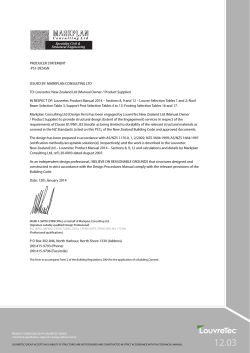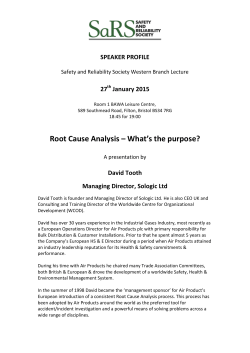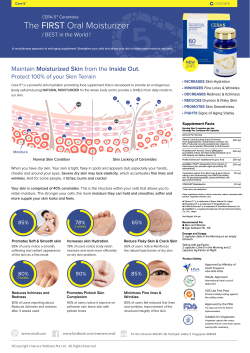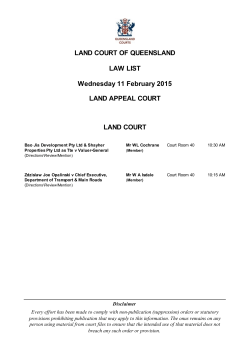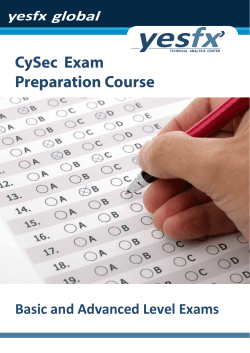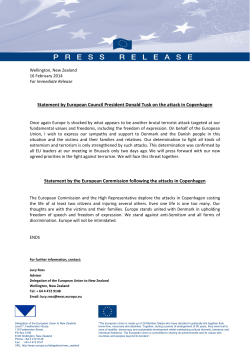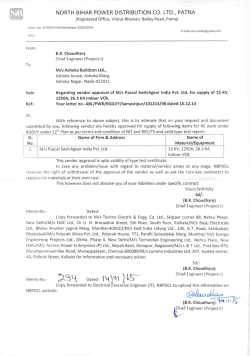
Grafton New Zealand Ltd.
Grafton New Zealand Ltd. Contact us : webmaster@grafton-nz.com Grafton New Zealand Ltd. What is Equixanthin TM ? ・ EquixanthinTM is produced by a natural (non-GMO) soil microbe using highly controlled cGMP fermentation and DSP facilities. ・ EquixanthinTM is a new, all natural source of Astaxanthin in the non-esterified form with 3S,3’S I isomer. ・ It is differentiated from other sources by being a natural blend of a number of antioxidant xanthophylls. ・ In addition to Astaxanthin, EquixanthinTM also contains Adonirubin and Adonixanthin, xanthophylls with 2-3 times the antioxidant power of Astaxanthin. ・ EquixanthinTM is stable and safe. Passed safety study for feed additives. < 3% loss after 1 month at room temperature(25℃). ・ EquixanthinTM improves many health conditions in horses: primarily azoturia/tying-up, susceptibility to ulcers, skin diseases, fertility issues in stallions and mares and throat infections in sale yearlings. Grafton New Zealand Ltd. 2 Equixanthin TM Production Overview Paracoccus carotinifaciens (natural soil microbe) Fermentation Grinding 0.2μm Concentration Mixing Drying EquixanthinTM Pasteurization Test assay Special mention: Ethoxyquin free, Non-feed & food additive, Non-GMO, RAC free, Dioxins free Grafton New Zealand Ltd. 3 Biosynthetic Pathway of Carotenoids Paracoccus carotinifaciens (natural soil microbe) Grafton New Zealand Ltd. 4 Composition of Equixanthin TM TYPICAL CONTENT ITEM TYPICAL CONTENT ITEM Inorganic Component, etc. Carotenoids Astaxanthin g/kg 21.7 Na g/kg 5.4 Adonirubin g/kg 5.3 P g/kg 6.7 Adonixanthin g/kg 2.9 Fe g/kg 1.9 Other Carotenoids g/kg 4.1 Ca g/kg 3.4 Total Carotenoids g/kg 34.0 K g/kg 2.5 Mg g/kg 2.7 Main Components Crude Protein g/kg 596 Lead ppm ND (QL: 0.1ppm) Crude Fat g/kg 37 Arsenic ppm ND (QL: 0.1ppm) Crude Ash g/kg 43 Mercury ppm ND (QL: 0.1ppm) Carbohydrate g/kg 285 Salmonella 25g Negative ND: Not detected, QL: Quantification Limit Grafton New Zealand Ltd. 5 Safety Study of Equixanthin TM ・ Bacterial Reverse Mutation Test (Ames test) ☞ EquixanthinTM is considered to be non-mutagenic. ・ Chromosome aberration Test (Human lymphocytes in vitro) ☞ EquixanthinTM is considered to be non-mutagenic. ・ Micronucleus Test (Rats) ☞ EquixanthinTM dose not induce micronuclei in bone marrow cells. ・ Acute Oral Toxicity Test (Rats) ☞ The acute oral median lethal dose (LD50) of EquixanthinTM is higher than 5000 mg/kg. ・ 90-Day Toxicity Study (Rats) ☞ No observed adverse effect level (NOAEL) of EquixanthinTM is higher than 3000 mg/kg/day. ・ Acute Inhalation Toxicity study (Rats) ☞ The acute inhalation median lethal concentration (4hr LC50) of EquixanthinTM is greater than 4.92 mg/L. Special mention: All studies were conducted in compliance with GLP. Grafton New Zealand Ltd. 6 Preservation Stability of Equixanthin TM 105 Conditions: 40℃, 75% R.H. Packaging: Usual seal in aluminum bag Degradation of Astaxanthin (Average SD) 100 95 90 85 0 1 3 6 12 18 24 30 36 Astaxanthin remaining (%) Astaxanthin remaining (%) Conditions: 25℃, 20-45% R.H. Packaging: Usual seal in aluminum bag 105 Degradation of Astaxanthin (Average SD) 100 95 90 85 0 1 Storage period (months) 95 90 85 2 3 Astaxanthin remaining (%) Astaxanthin remaining (%) 100 1 12 Conditions: 25℃, 20-45% R.H. Packaging: Open aluminum bag in the dark Degradation of Astaxanthin 0 6 Storage period (months) Condition: 60℃ Packaging: Usual seal in aluminum bag 105 3 105 Degradation of Astaxanthin 100 95 90 85 Storage period (months) 0 1 2 3 Storage period (months) Grafton New Zealand Ltd. 7 Antioxidant Action of Astaxanthin 1st action: Elimination of Singlet Oxygen Oxygen O2 1O Astaxanthin 2 Singlet Oxygen Oxygen O2 Lipid Superoxide anion radical Hydrogen peroxide Hydroxyl radical Lipid Oxygen Lipid Radical Lipid peroxyl radical Lipid peroxide autoxidation Astaxanthin 2nd action: Inhibition of Lipid Peroxidation Grafton New Zealand Ltd. 8 Utility in Clinical Practice by Astaxanthin 1.Antioxidant action ・ muscle fatigue resistance ・ prevention of tying-up syndrome ・ improvement of conception rate ・ adjustment of estrous cycle & heat-stress relief ・ enhancement of immune system ・ anti-inflammatory & anti-photoaging effect ・ prevention of metabolic syndrome, etc. 2.Unknown action Do not drop the body weight ! ・ improvement of intestinal flora ? High-fat diet High-fat diet) 0.02 % Astaxanthin It’s extremely important for health maintenance. Astaxanthin effect Abnormal intestinal flora + Normal intestinal flora 【Authority】 Effects of Astaxanthin on Intestinal Micro flora in Mice Fed a High-fat Diet. Anti-aging medicine. 10(4), 77-91, 2013 Grafton New Zealand Ltd. 9 Administration of EquixanthinTM Astaxanthin concentration in horse serum (µg/L) Temporal change in Astaxanthin (Average SD) 1.0 0.9 Test methods 1. Horses Administration period: 14 day ・ 8 thoroughbreds (breeding mares) ・ age: 3~14 years ・ body weight: 651±35 kg 0.8 0.7 2. Dose ・ 50 mg astaxanthin※×2 times /day ・ total daily dose: Ax 100 mg / head ※ EquixanthinTM (Grafton NZ Ltd.) 0.6 0.5 0.4 3. Administration Period 0.3 ・ 14 day continuousadministration 0.2 4. Blood Sampling Point 0.1 0.0 0 1 3 4 7 8 12 14 ・ 1, 3, 7, 14, 21, 28 day 16 20 21 24 28 Time after administration (Day) 5. Analysis of Astaxanthin in serum ・ HPLC ・ Silica gel, Acetone: Hexane (2:8) Blood concentration of astaxanthin achieves a stable state from day 7 after the start of the administration. Grafton New Zealand Ltd. 10 Anti-oxidative Activity of Adonirubin and Adonixanthin (1) Elimination of Singlet Oxygen (1O2) Adonirubin and Adonixanthin react more efficiently with 1O2 than astaxanthin. Carotenoid Relative activity Astaxanthin 1 Adonirubin 2.3 Adonixanthin 2.9 (3S,3’S)-Astaxanthin ☞ (3S)-Adonirubin ESR signal intensity (3S,3’R)-Adonixanthin 4.0 Quenching activity of 1O2 in aqueous solution (Average SD) 3.0 2.0 3.20 * 2.35 1.0 ** 1.01 0.0 Control Astaxanthin Adonirubin ** 0.81 Adonixanthin Quenching activity of 1O2 produced by a hematoporphyrin-UVA system in aqueous solution by carotenoids. The reaction mixtures consisted of 62.5 μM hematoporphyrin and 50 mM TMPD dissolved in 50 mM phosphate buffer, and 625 μM astaxanthin, adonirubin, or adonixanthin dissolved in acetone at 22℃ in a total volume of 0.2 mL of 50 mM phosphate buffer (pH 7.5). Results of ESR spin-trapping experiments are expressed as the mean ± SD of three repeated experiments. Statistical analysis was performed by analysis of variance (ANOVA) followed by Post-hoc test with a 1 % or 5 % significance of difference. There were significant differences (* P < 0.05, ** P < 0.01) in the 1O2 quenching activities of carotenoid treatment groups compared with the control group. (2) Inhibition of Lipid Peroxidation Adonirubin and Adonixanthin show slightly weaker activity than astaxanthin. 【Authority】 Anti-oxidative, anti-tumor-promoting, and anti-carcinogenic activities of adonirubin and adonixanthin. J. Oleo Sci. 62(3), 181-186, 2013 Grafton New Zealand Ltd. 11 Natural Astaxanthin from Paracoccus carotinifaciens Imported by: Grafton New Zealand Ltd contact us: webmaster@grafton-nz.com Products available from: Grafton New Zealand Ltd. contact us: webmaster@grafton-nz.com Products available in Australia from: Beamish Bloodstock Pty. Ltd. contact: beama888@gmail.com Grafton New Zealand Ltd.
© Copyright 2025
